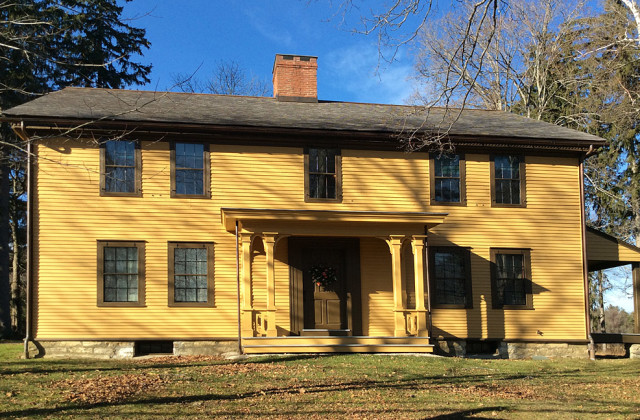Melville, the Mountain and Moby Dick
By Michael Kelly
Only a writer with Herman Melville’s phantasmagorical imagination could look out his window in the Berkshire Hills of Western Massachusetts at Mount Greylock, 16 miles due north, and envision a great white whale surfacing for air in the remote seas of the South Pacific. Yet this is precisely what Melville did in the winter of 1850-1851 when he was living with his wife Lizzie, her mother, four children, three sisters and various other relatives at Arrowhead, his 1785 farmhouse on 160 acres in Pittsfield, Mass.
He wrote to a friend that winter, “I have a sort of sea-feeling here in the country now that the ground is all covered with snow. I look out my window in the morning when I rise as I would out of a port-hole of a ship… My room seems a ship’s cabin; and at nights when I wake up and hear the winds shrieking, I almost fancy there is too much sail on the house, and I had better go on the roof and rig the chimney.”
For 13 years, from 1850 to 1863, Melville did some of his finest writing at Arrowhead—“Pierre”, “The Confidence Man”, “The Piazza Tales”, “I and My Chimney”, “Bartleby the Scrivener” and his masterwork, “Moby Dick”.
Melville’s uncle owned an 18th century farmhouse called Broad Hall (which is now part of the clubhouse of the Country Club of Pittsfield) that he visited often in his youth. Enraptured by the natural beauty of the Berkshires, which at the time were favorably compared to England’s Lake District, Melville, at age 31, impulsively bought the farm adjacent to Broad Hall, where he grew crops and found the peace and solitude to carry on with his writing career. He named his farm Arrowhead after the many Indian artifacts that turned up when he tilled the soil.
At 9:30 every morning, after feeding his horse Charlie in the barn, Melville lit a fire in his upstairs study with its commanding view of Mt. Greylock, the highest peak in Massachusetts. Barricading himself in his metaphorical Pequod, Melville grappled vehemently with the elusive great white whale in his imagination, and in his burgeoning manuscript. After a late lunch, Melville would tend to the farm and, in winter, take members of his family on a sleigh ride into the village of Pittsfield to shop and pick up his mail.
Moving to Pittsfield was intellectually fortuitous for Melville. Less than six miles away, in Stockbridge, Nathaniel Hawthorne was renting a cottage with his family where he too was busy, writing such classics as, “The House of the Seven Gables”, “Tanglewood Tales” and “The Blithedale Romance”.
The two literary leviathans first met at a now celebrated champagne-fueled picnic on Monument Mountain in Great Barrington on August 5, 1850. Taking cover during a sudden thunderstorm, the pathologically shy Hawthorne and grandiloquent Melville established an immediate rapport. Melville developed a keen affection for Hawthorne, 15 years his senior, and dedicated Moby Dick to him with the words, “In token of my admiration for his genius.” Hawthorne also acknowledged Melville’s genius, marveling, “There sits Melville in Pittsfield shaping out the gigantic conception of his white whale while staring at the snow covered mountain…”
They spent many stimulating hours in Melville’s barn sipping brandy while discussing the human heart and the vicissitudes of the writing life. Not loving the Berkshires as much as his new friend, Hawthorne moved back to Concord in 1852, perhaps in part, to distance himself from the infatuated Melville.
Meanwhile, Melville reveled in and wrote paeans to the beauty of the Berkshires. In the poem, “Pontoosac,” he rhapsodizes about “a lovely autumnal scene, with orderly pine trees crowning a bluff over a gleaming lake,” and he dedicated “Pierre” to Mt. Greylock’s ‘purple majesty’.
After 13 years, financial difficulties (“Moby Dick” was a commercial failure and was never heralded in Melville’s lifetime) prompted him to reluctantly move with his family back to New York where he worked as a customs inspector for the next 20 years. He sold Arrowhead to his brother and visited frequently until the 1880’s. It remained in the Melville family until 1927 and thereafter was privately owned until it was acquired in 1975 by the Berkshire Historical Society, renovated and opened to the public.
In Norfolk, we are fortunate to live on the doorstep of the Berkshires with its plenitude of cultural institutions, theaters, museums and natural beauty. Arrowhead is located at 780 Holmes Road in south Pittsfield, only 36 miles from Norfolk’s Village Green. Open daily from Memorial Day weekend to Columbus Day, hourly guided tours begin at 10 a.m. and end at 4 p.m. The grounds and walking trails are open year-round until dusk.
Tours start in the barn, where Melville and Hawthorne talked and drank the hours away, and continue into the farmhouse. On the first floor, the center chimney that inspired “I and My Chimney” is still covered with Melville’s brother’s vivid inscriptions. Upstairs is Lizzy and Herman’s bedroom next to the room where Hawthorne slept when he stayed overnight. Across the hall is Melville’s study, where you may well imagine him toiling fervidly on his proliferating manuscripts. Through the window you will relish the same panoramic view of Mt. Greylock from which he wrested his magnum opus.
On Sunday, May 22 from 10 a.m. to 2 p.m., Arrowhead’s writer-in-residence will conduct a writer’s workshop in Melville’s study. ($60, including lunch). To sign up, and for more information on Arrowhead, go to www.mobydick.org.
Photo, by Michael Kelly, shows Arrowhead, Melville’s longtime home in the Berkshires.


Wonderfully composed, eloquently scribed informational article.